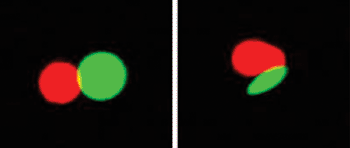T-cells Activated More Effectively by Ellipsoidal Artificial Antigen-Presenting Cells
By LabMedica International staff writers
Posted on 21 Oct 2013
Artificial antigen-presenting cells (aAPCs) shaped like American footballs were able to activate immune system T-cells to attack and destroy cancer cells much more effectively than spherical aAPCs.Posted on 21 Oct 2013
When circulating T-cells interact with APCs, they become conditioned to recognize foreign proteins, so that if the T-cells encounter those proteins again, they are able to divide rapidly to create a multitude of defensive cells that attack and destroy the cells bearing those antigens.

Image: T-cells (red) are activated more robustly when they interact with artificial antigen-presenting cells (green) that are elongated (right) versus round (left) (Photo courtesy of Dr. Karlo Perica, Johns Hopkins University).
While both forms of aAPCs are able to express suitable levels of surface antigens, ellipsoidal particles were found to contact an appreciably greater amount of the T-cell membrane surface than did spherical particles.
Investigators at Johns Hopkins University (Baltimore, MD, USA) reported in the October 5, 2013, online edition of the journal Biomaterials that ellipsoidal biomimetic aAPCs significantly enhanced in vitro and in vivo activity above that of spherical aAPCs with similar volume and antigen content. Confocal imaging studies indicated that CD8+ T-cells preferentially migrated to and were activated by interaction with the long axis of the aAPC. Importantly, enhanced activity of ellipsoidal aAPCs was seen in a mouse melanoma model, with the football shaped particles improving survival of test mice compared to spherical aAPCs.
"The shape of the particles really seems to matter because the stretched, ellipsoidal particles we made performed much better than spherical ones in activating the immune system and reducing the animals' tumors," said senior author Dr. Jordan Green, assistant professor of biomedical engineering at Johns Hopkins University. "When immune cells in the body come in contact, they are not doing so like two billiard balls that just touch ever so slightly. Contact between two cells involves a significant overlapping surface area. We thought that if we could flatten the particles, they might mimic this interaction better than spheres and activate the T-cells more effectively. This adds an entirely new dimension to studying cellular interactions and developing new artificial APCs. Now that we know that shape matters, scientists and engineers can add this parameter to their studies."
Related Links:
Johns Hopkins University







 Analyzer.jpg)





